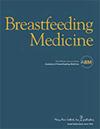巴氏杀菌人乳中的脂肪含量和能量计算:红外分析法与奶油比容法的比较
IF 2.1
3区 医学
Q2 OBSTETRICS & GYNECOLOGY
引用次数: 0
摘要
目的:本研究旨在使用红外分析法和乳脂率法分析和比较巴氏杀菌人乳(HM)样品中的能量和脂肪含量。方法:横断面研究这项横断面研究分析了来自一个中心的 317 位母亲的 1858 份巴氏杀菌母乳样本。采用红外线透射分光光度法(Miris,人乳分析仪 [HMA],瑞典乌普萨拉)和乳脂率法评估巴氏杀菌人乳样本中的能量和脂肪含量。结果捐献母亲的平均年龄为 29.7 ± 5.1 岁,泌乳时间中位数为 22 天(四分位数间距 [IQ]:7.7-59.2)。有 196 名(95.1%)妇女足月分娩。用 Miris 方法获得的 HM 样本中的能量值(差异:+8.96 千卡/分升,95% CI:8.52-9.44 千卡/分升;p < 0.001)和脂肪值(差异:+0.40 克/分升,95% CI:0.35-0.45 克/分升;p < 0.001)高于用乳脂率法获得的数值。用 Miris 计算出的高密度脂蛋白样本中的能量和脂肪与用乳脂率法得出的结果直接呈中度相关(脂肪,r = 0.585;p < 0.001;能量,r = 0.591;p < 0.01)。根据母体年龄和泌乳时间调整后的线性回归结果显示,乳脂率计算出的能量值与米瑞斯计算出的能量值直接相关(能量千卡/毫升 = 38.43 + [0.516 × 乳脂率的千卡/毫升])。结论用奶油容积法和红外线法得到的巴氏杀菌乳脂样品的能量和脂肪量有显著的相关性。然而,乳脂率法计算出的数值明显低于红外线分析仪计算出的数值。本文章由计算机程序翻译,如有差异,请以英文原文为准。
Fat Content and Energy Calculation in Pasteurized Human Milk: Comparison Between Infrared Analysis and Creamatocrit Method.
Aims: This study aimed to analyze and compare the quantity of energy and fat using the infrared analysis and creamatocrit method in pasteurized human milk (HM) samples. Methods: This cross-sectional study analyzed 1,858 pasteurized human samples from 317 mothers at a single center. Infrared transmission spectrophotometry (Miris, Human Milk Analyser [HMA], Uppsala, Sweden) and the creamatocrit method were used to evaluate the quantity of energy and fat in pasteurized HM samples. Results: The average age of donor mothers was 29.7 ± 5.1 years, and the median duration of lactation was 22 days (interquartile range [IQ]: 7.7-59.2). Full-term births were observed in 196 (95.1%) of the women. The values of energy (difference: +8.96 kcal/dL, 95% CI: 8.52-9.44 kcal/dL; p < 0.001) and fat (difference: +0.40 g/dL, 95% CI: 0.35-0.45 g/dL; p < 0.001) in HM samples obtained by Miris were higher than those by the creamatocrit method. The energy calculated and the fat measured by Miris in the HM samples correlated moderately and directly with the obtained by creamatocrit (fat, r = 0.585; p < 0.001 and energy, r = 0.591; p < 0.01). The linear regression, adjusted for maternal age and lactation time, showed that the energy values calculated by creamatocrit were directly associated with those of Miris (energy kcal/dL = 38.43 + [0.516 × kcal/dL of creamatocrit]). Conclusion: The energy and fat quantity of pasteurized HM samples obtained by the creamatocrit and infrared methods were significantly correlated. However, the values calculated by the creamatocrit method were significantly lower than those by the infrared analyzer.
求助全文
通过发布文献求助,成功后即可免费获取论文全文。
去求助
来源期刊

Breastfeeding Medicine
OBSTETRICS & GYNECOLOGY-PEDIATRICS
CiteScore
4.20
自引率
11.10%
发文量
130
审稿时长
6-12 weeks
期刊介绍:
Breastfeeding Medicine provides unparalleled peer-reviewed research, protocols, and clinical applications to ensure optimal care for mother and infant. The Journal answers the growing demand for evidence-based research and explores the immediate and long-term outcomes of breastfeeding, including its epidemiologic, physiologic, and psychological benefits. It is the exclusive source of the Academy of Breastfeeding Medicine protocols.
Breastfeeding Medicine coverage includes:
Breastfeeding recommendations and protocols
Health consequences of artificial feeding
Physiology of lactation and biochemistry of breast milk
Optimal nutrition for the breastfeeding mother
Breastfeeding indications and contraindications
Managing breastfeeding discomfort, pain, and other complications
Breastfeeding the premature or sick infant
Breastfeeding in the chronically ill mother
Management of the breastfeeding mother on medication
Infectious disease transmission through breast milk and breastfeeding
The collection and storage of human milk and human milk banking
Measuring the impact of being a “baby-friendly” hospital
Cultural competence and cultural sensitivity
International public health issues including social and economic issues.
 求助内容:
求助内容: 应助结果提醒方式:
应助结果提醒方式:


